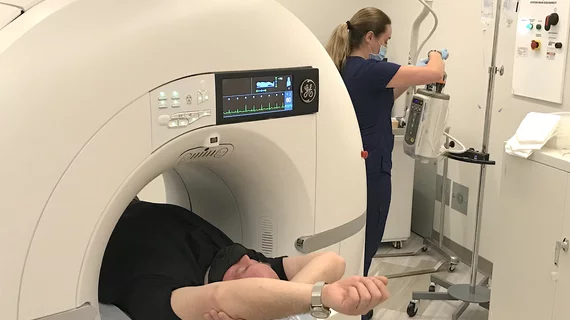Challenged to maintain service levels during the present shortage of iodinated contrast agents (ICAs) for CT scans, researchers at a quaternary academic medical center have developed a short-term workaround that they report is now reducing the institution’s ICA consumption by more than 50% without compromising care quality.
Mahmud Mossa-Basha, MD, and radiology colleagues at the University of North Carolina at Chapel Hill share their overall strategy and targeted tactics in special commentary published online May 17 in JACR [1].
“The ACR Committee on Drugs and Contrast Policy published guidelines on approaches during the ICA shortage, which include diverting imaging to other modalities (noncontrast CT, MRI, ultrasound) when possible, use of alternative brand ICA [to stand in for GE Healthcare’s Omnipaque (iohexol), reduced individual dosing and supply prioritization,” the authors write to introduce their article. “Our target was to reduce contrast usage by 50% to 70% in a short period of time.”
Toward that end, UNC-Chapel Hill’s radiology department co-led UNC Health—with cardiology and hospital operational leadership—in modifying CT scan protocols, substituting MRI and ultrasound for CT, working with nonradiology provider teams, and prioritizing interventional and neuro-interventional radiology procedures by acceptable delay times.
Mossa-Basha and co-authors list various changeable exams and procedures under six categories. Here are illustrative examples from each:
1. CT examinations switched from contrast-enhanced CT to noncontrast CT: chest CTs for evaluation of cancer or mediastinal disease; abdominal CT for pain with concern for appendicitis, hernia, diverticulitis and abscess; cardiothoracic CT for status check of post-endovascular aneurysm repair ...
2. CT exams for which Omnipaque can continue to be administered unabated: CT pulmonary embolism; CT angiography for evaluation of aortic dissection in unstable patients; CT angiography or CT perfusion for stroke code ...
3. Contrast dosing adjustments: CT transcatheter aortic valve replacement (TAVR)—dose reduced from 150mL to 60-80mL; CT pulmonary embolism—from 75mL to 50mL ...
4. CT exams redirected to MRI when possible: from CT abdomen/pelvis for right upper quadrant pain to MRI abdomen or magnetic resonance cholangiopancreatography (MRCP) ...
5. Prioritization of neuro-interventional procedures: Emergent: stroke thrombectomy, ruptured aneurysms, carotid blowout. Delay one month: elective unruptured aneurysm, arteriovenous fistula. Delay three months: follow-up diagnostic angiograms, tumor embolizations and spinal angiograms ...
6. Prioritization of interventional radiology procedures: Emergent: large splenic aneurysms with impending rupture, acute venous thromboembolic event with complicating features, Percutaneous biliary and nephrostomy drainages for obstruction with sepsis. Delay one month: interventional oncology procedures, venography for dialysis access planning. Delay three months: venous embolizations, recanalizations, malformations and stenting ...
“Considering the limited supply our institution currently has, we are reviewing the protocols for every contrast-enhanced CT examination already scheduled to prioritize contrast administration,” the authors write.
They note the difficulty of finding alternative contrast vendors due to widespread scrambling as well as stockpiling.
A notable exception has been UNC’s switching from GE’s Omnipaque to Bracco’s Gastrografin and Beekley Medical’s Breeza when CT oral contrast is needed for body imaging.
Mossa-Basha et al. conclude:
We have achieved significant contrast use reduction, exceeding our target of 50% reduction. Conversion of contrast-enhanced to noncontrast and elective examination delays have thus far been successful; however, we are still working toward redirecting volume to MRI. Limitations to this report are it reports on a single institution’s experience that relies exclusively on iohexol, which may limit generalizability.”
More Coverage of the Omnipaque (iohexol) Shortage:
GE provides update on contrast media shortage
AHA presses GE for a detailed progress report on CT contrast shortage
Frontline perspectives on the CT contrast shortage: 5 notable quotes
Preserving contrast media supplies: 7 ACR recommendations
Be prepared: IV contrast media shortage could last up to 8 weeks
Reference:
- Gloria Gonzalez, Mahmud Mossa-Basha, Maureen Kohi, Lauren M. Burke, “Short-Term Mitigation Steps During the Iohexol Contrast Shortage: A Single Institution’s Approach.” Journal of the American College of Radiology, May 17, 2022. DOI: https://doi.org/10.1016/j.jacr.2022.05.004

